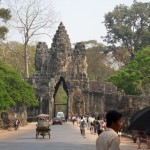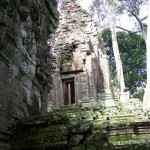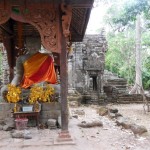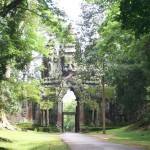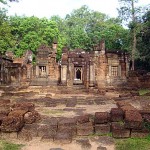The Angkor Large Circuit will take a full day to complete, with plenty to see and do. All of the sights are located within the Angkor Archaeological Park which is only a short 6 kilometer ride by Tuk Tuk from Siem Reap.There are plenty of little local shops and vendors along the Large Circuit to buy cheap food, snacks, fresh fruit and cold bottles of water. Try a fresh pineapple sliced up in front of you, delicious and refreshing.
Angkor Large Circuit Temples
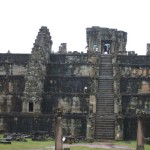 Phnom Bakheng – Just past Angkor Wat and before you get to the South Gate of Angkor Thom you will find the 5 terraced temple mountain Phnom Bakheng. Built in the 9th century this was the first major temple to be constructed in the Angkor area when the Khmer empire moved from Roluos.
Phnom Bakheng – Just past Angkor Wat and before you get to the South Gate of Angkor Thom you will find the 5 terraced temple mountain Phnom Bakheng. Built in the 9th century this was the first major temple to be constructed in the Angkor area when the Khmer empire moved from Roluos.
Unlike other temples the foundations for Phnom Bakheng were carved from the existing hilltop rock on which it majestically sits. The hilltop location makes it the most popular spot to view the Angkor sunset, offering widespread views.
Elephant rides up and down the hill are also available from about 4:00 PM till sunset.
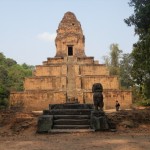 Baksei Chamkrong – 100 meters past Phnom Bakheng towards the South Gate to Angkor Thom are several temples. The first is Baksei Chamkrong.
Baksei Chamkrong – 100 meters past Phnom Bakheng towards the South Gate to Angkor Thom are several temples. The first is Baksei Chamkrong.
Construction began in early 10th Century by King Harshavarman I, and was finished by King Rajendravarman II in the same century.
A towering 12-meter tall terraced pyramid it was one of the first temples to be constructed with brick and laterite with decorations in sandstone.
At the top of the pyramid is a brick sanctuary tower with a reclining Buddha image inside. On its door frame are inscriptions mentioning the names of many early Khmer Kings.
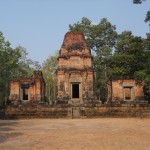 Prasat Bei – Between Baksei Chamkrong and the moat that surrounds Angkor Thom is a set of three brick towers, this is Prasat Bei.
Prasat Bei – Between Baksei Chamkrong and the moat that surrounds Angkor Thom is a set of three brick towers, this is Prasat Bei.
Prasat Bei literally means ‘towers three.’ Built in the 10th Century by King Yasovarman I, although it appears that it may never never have been completed.
The central tower is 10 meters tall. Some of the carvings on the door lintels still survive. On the middle tower is a linga.
The two side towers are severely ruined, and only reach up to the doorway of the central tower.
After leaving Prasat Bei you pass through the South Gate of Angkor Thom.
Angkor Thom is another walled and moated temple city.
Built by King Jayavarmam VII in the early 13th century it covers about 3km square.
At the South Gate you will often see the elephants that carry people up to the top of the nearby Phnom Bakheng temple which is a good place to see the sunset or sunrise over Angkor Wat.
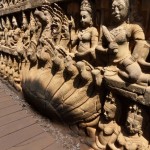 Terrace of Leper King – Go through the South Gate, past the Bayon and the Terrace of the Leper King is a raised platform located at the north end of the Terrace of Elephants. Possibly built by King Jayavarman Vii in the 12 century. The terrace was named for the statue of the ‘Leper King’ that sits on top. This statue is a replica of the original statue which is kept in the National Museum in Phnom Penh.
Terrace of Leper King – Go through the South Gate, past the Bayon and the Terrace of the Leper King is a raised platform located at the north end of the Terrace of Elephants. Possibly built by King Jayavarman Vii in the 12 century. The terrace was named for the statue of the ‘Leper King’ that sits on top. This statue is a replica of the original statue which is kept in the National Museum in Phnom Penh.
The Terrace is covered with hundreds of beautifully carved nagas (serpents), demons and other mythological beings. It has a zig-zag walkway inside where you can see the inner wall with all it’s carvings.
There is a hidden section within the Terrace. Climb up on top of the terrace then climb down a flight of stairs to the internal section. Some beautifully carved elephants are in here.
From the Terrace of the Leper King head 100 north to Tep Pranam then head west for 150 meters towards the back of Angkor Thom. There you will find Preah Palilay.
Beyond the Tep Pranam seated Buddha image is the inner enclosure wall of Preah Palilay. Built sometime between the 12th and 14th century Preah Palilay is now surrounded by tall silk-cotton trees.
The central tower remains thou it is in poor condition, currently being renovated. The eastern tower displays some particularly good Buddhist carvings.
Heading east back to the main road you will find a long walkway with a Buddha figure at the far end. This is Tep Pranam.
Built in the 9th century as a Buddhist shrine by King Yasovarman I. It was expanded and modified during the 12th and 13th centuries to include balustrades, lions and other additions.
The Tep Pranam Buddha image is now housed under a modern structure. The original wooden shrine building would have disappeared long ago.
The Buddha is seated in a lotus position.
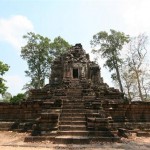 Preah Pithu – Going back to the main road and crossing it head east a short distance till you come to a group of temple ruins. This is Preah Pithu. Preah Pithu is not one, but five different ruins that are clumped together and called Preah Pithu.
Preah Pithu – Going back to the main road and crossing it head east a short distance till you come to a group of temple ruins. This is Preah Pithu. Preah Pithu is not one, but five different ruins that are clumped together and called Preah Pithu.
These temples may have been built by different Kings in different centuries. To differentiate the five ruins, archaeologists call them Temple T, Temple U, Temple V, Temple X and Temple Y. All are Hindu temples except for temple Temple X which is Buddhist. The temple closest to the Terrace of the Elephants is Temple T, and behind it Temple U, both surrounded by the same moat. East of Temple U, and northwards is Temple X. North of Temple X is Temple V with it’s long causeway. 30 meters north of Temple V is Temple Y.
It is a nice quite area and a good place to stop for a drink and a bite to eat away from the crowds.
After leaving Preah Pithu take the Tuk Tuk north to the North Gate of Angkor Thom.
Built by King Jayavarmam VII in the early 13th century this is one of five entrance gates to the main Angkor Thom complex.
The wall around the Angkor Thom complex is 8 meters high.
The gates set in the wall are all around 20 meters tall.
This would have to be one of the prettiest of the gates, in a peaceful wooded setting.
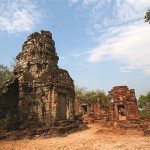 Banteay Prei (and Prasat Prei)
Banteay Prei (and Prasat Prei)
Passing through the North Gate you come to 2 small temples on your left, Prasat Prei and Banteay Prei.
A small temple in a peaceful forest setting, Prasat Prei was built in the 12th century by King Jayavarman VII.
The central tower and some halls still remain. Follow the pathway past Prasat Prei and you will come to Banteay Prei, also built in the 12th century by King Jayavarman VII.
Some of the door lintel and apsara carvings are in good condition. Only has very small doors and windows for a temple.
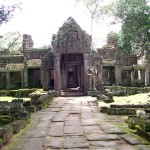 Preah Khan – Across the road from Prasat Prei is the huge Buddhist monastery complex of Preah Khan that at one stage housed over 1000 Buddhist monks.
Preah Khan – Across the road from Prasat Prei is the huge Buddhist monastery complex of Preah Khan that at one stage housed over 1000 Buddhist monks.
It was built in the late 12th Century by King Jayavarman VII in honour of his father.
This massive complex is just full of carvings and passageways. Some of the Buddha images have been damaged by later crude Hindu over-carvings. The site on which Preah Khan sits was previously the palace of the earlier King Yasovarman II.
Near the eastern end of Preah Khan is a two story structure which is the only one of its kind in Angkor. Preah Khan also served for a while as the temporary residence of Jayavarman VII while his Royal Palace was being constructed at Angkor Thom.
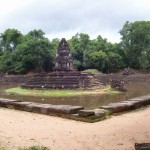 Neak Pean – About 2km down the road from Preah Khan you come to Neak Pean.
Neak Pean – About 2km down the road from Preah Khan you come to Neak Pean.
Neak Pean was built in the late 12th Century by Jayavarman VII. This is one of the most unique Buddhist temples in Angkor. It was originally located on an island in the middle of a great man-made baray (lake). The baray dried up a long time ago and is now just forest.
A central temple forms it’s own little island in the center of a cross pattern of eight pools, and encircled by entwined nagas (serpents). The name “Neak Pean” means entwining serpents. In the wet season the pools are all full, but in the dry season you can walk in the dry pools.
Look for the elephant and other water spouts in the outer walls of each pool.
Just a short distance away across the road from Neak Pean is the small temple of Krol Ko.
Krol Ko was built in the late 12th century by King Jayavarman VII.
A small temple with a central tower surrounded by laterite stone walls.
The internal court is enclosed in a wall of some 35 meters by 25 meters.
The outer wall is surrounded on three sides by a stepped moat.
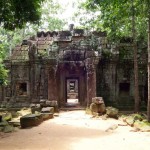 Ta Som – About 1km down the road from Krol Ko you will come to Ta Som. Ta Som was built in the late 12th Century by King Jayavarman VII. Its original name when built was Gaurasrigajaratna, meaning “Jewel of the Propitious White Elephant”.
Ta Som – About 1km down the road from Krol Ko you will come to Ta Som. Ta Som was built in the late 12th Century by King Jayavarman VII. Its original name when built was Gaurasrigajaratna, meaning “Jewel of the Propitious White Elephant”.
Ta Som is a relatively small monastic complex, a little like Ta Prohm. It has a simple design of three concentric enclosures, with the outer enclosure wall measuring 240 meters by 200 meters. After you have entered the west gopura, you will notice the moat around the second enclosure. Look for the huge tree that has wrapped itself on the east gopura, good photo opportunity. Many of the carvings are in good condition especially the Devata carvings.
You are now at the furthermost place away from Siem Reap. Now you start the homeward leg.
 East Mebon – Leaving Ta Som behind, go down the road about 2km and find East Mebon.
East Mebon – Leaving Ta Som behind, go down the road about 2km and find East Mebon.
East Mebon was a temple mountain built in the late 10th Century by King Rajendravarman II, and dedicated to Shiva in honor of the king’s parents. Originally East Mebon sat on an island in the middle of the vast East Baray. The East Baray was an artificial lake/reservoir that measured 7km by 2km. In ancient times you would have used a boat to get out to the temple. Now the Baray has dried up you can use a Tuk-Tuk.
This temple mountain rises up three levels and is crowned by five towers. Good views of the countryside from up on top. The decoration on the door lintels and the motifs on the false doors on each tower are very detailed.
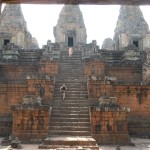 Pre Rup – About 1km down the road from East Mebon you will come to the mighty Pre Rup. This massive temple-mountain was built in the late 10th Century by King Rajendravarman II to be his State temple. Although similar in style to East Mebon, Pre Rup is architecturally and artistically superior. Beautifully carved false doors on upper level. The well-preserved carvings found here are rich in detail. A laterite stone wall surrounds the temple on each side, with a big gopura with three doorways in each wall.
Pre Rup – About 1km down the road from East Mebon you will come to the mighty Pre Rup. This massive temple-mountain was built in the late 10th Century by King Rajendravarman II to be his State temple. Although similar in style to East Mebon, Pre Rup is architecturally and artistically superior. Beautifully carved false doors on upper level. The well-preserved carvings found here are rich in detail. A laterite stone wall surrounds the temple on each side, with a big gopura with three doorways in each wall.
Entering from the main entrance at the east gopura, there is a row of six towers, grouped three on each side. A steep staircase leads you up to the first level, which has gopuras at the cardinal points. The staircase then leads up to the second level, which has two libraries facing east. Up the staircase again to the third and final level, where there are four towers. From the top level you get good views of the surrounding countryside.
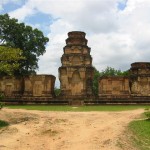 Prasat Kravan – Head back toward Siem Reap away from Pre Rup and you will come to Prasat Kravan. Prasat Kravan was built in the early 10th Century during the reign of King Harshavarman I and is dedicated to Vishnu. This temple has five sanctuary towers arranged side by side on the same platform orientated north to south, with a terrace in front.
Prasat Kravan – Head back toward Siem Reap away from Pre Rup and you will come to Prasat Kravan. Prasat Kravan was built in the early 10th Century during the reign of King Harshavarman I and is dedicated to Vishnu. This temple has five sanctuary towers arranged side by side on the same platform orientated north to south, with a terrace in front.
Prasat Kravan is renown for its remarkable brick sculptures which are unique and in a very different style from the other Angkor temples. The towers were restored in the 1960s as evidenced by the replacement bricks that are marked “CA” (Conservation Angkor). The best preserved door lintel is on the southern sanctuary. It shows Vishnu on a garuda, and the garuda is clutching the head of a naga. The northern and central towers have interior bas-relief brick carvings, found nowhere else in Angkor.
Prasat Kravan is the last Angkor Temple to see on the Large Circuit. Now we head back to Siem Reap. If you want to see more about my Angkor Tours, go to my Tours page. I hope you enjoyed your trip around the Angkor Large Circuit.

